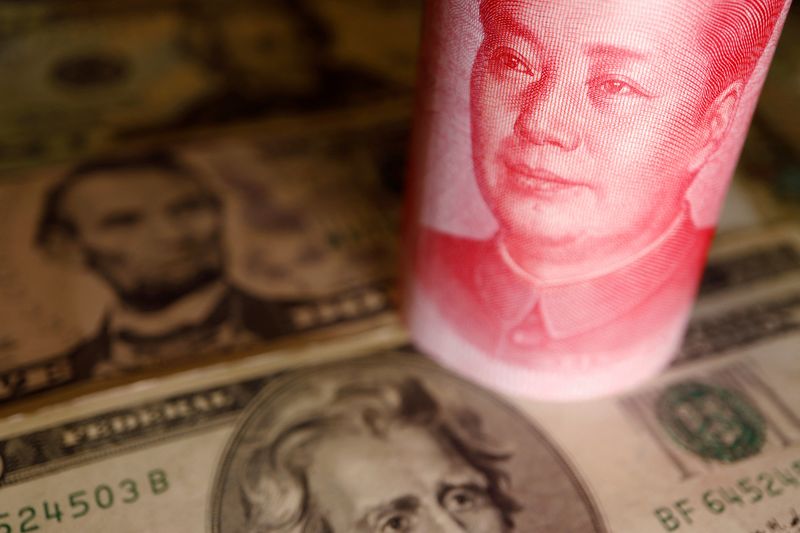 © Reuters. FILE PHOTO: U.S. Dollar and Chinese Yuan banknotes are seen in this illustration picture taken June 14, 2022. REUTERS/Florence Lo/Illustration
© Reuters. FILE PHOTO: U.S. Dollar and Chinese Yuan banknotes are seen in this illustration picture taken June 14, 2022. REUTERS/Florence Lo/Illustration
By John McCrank
NEW YORK (Reuters) -The dollar was rangebound on Tuesday, hovering around its weakest level in seven months versus the euro and a group of other major currencies, as traders awaited U.S. inflation data later this week to help firm up interest rate hike expectations.
The euro was up 0.1% against the greenback to $1.07415 at 3:20 p.m. EST (2020 GMT), just below a seven-month high of $1.07605 hit on Monday. Sterling dipped 0.18% to $1.21585, just below Monday's three-week top.
The dollar has been trending lower as investors and traders question whether the Federal Reserve will have to increase its target interest rate beyond 5% to curb stubbornly high inflation, as the effects of the U.S. central bank's aggressive hikes in borrowing costs in 2022 have already begun to show.
Data last week showed that while the U.S. economy added jobs at a solid clip in December, wage growth slowed, while another report showed that services activity weakened.
U.S. Consumer Price Index (CPI) data for December is due on Thursday and is one of the last major economic reports before the Fed's Jan. 31-Feb. 1 policy meeting.
"That FX markets are treading water ahead of key U.S. CPI data ... is no real surprise given the amount of emphasis bond markets are putting on that data," analysts from ANZ Research said.
Investors now expect the federal funds rate to peak just under 5% by June, before starting to come down later in the year.
Atlanta Fed Bank President Raphael Bostic and San Francisco Fed President Mary Daly said on Monday that rates have further higher to go and will remain at elevated levels.
Fed Chair Jerome Powell avoided speaking about rate hikes in a speech in Sweden on Tuesday.
"Until a more hawkish Fed narrative emerges, the dollar is likely to remain under pressure," said Win Thin, global head of currency strategy at Brown Brothers Harriman, who added that current dollar weakness may be overdone.
The U.S. dollar index which tracks the greenback against a basket of currencies, with the euro given the greatest weight, was up 0.039% at 103.21, having tumbled 0.7% and touched a seven-month low of 102.93 in the previous session.
It was unclear if the dollar's safe-haven status would help it or hurt it going forward.
The World Bank slashed its 2023 growth forecasts to near recession levels for many countries as the impact of central bank rate hikes intensifies, Russia's war in Ukraine continues, and the world's major economic engines sputter.
Goldman Sachs (NYSE:GS), however, said it no longer expects Europe to fall into a recession in 2023 due to a decline in natural gas prices and the reopening of China's borders.
China's rapid reopening of its borders following COVID-19 pandemic restrictions provided another boost toward riskier assets and currencies this week away from the safe-haven appeal of the greenback, particularly moving China-linked currencies.
The China-sensitive Australian dollar spiked at more than a four-month peak of $0.6950 in the previous session. It was last 0.3% lower at $0.6893.
The offshore yuan last traded at 6.7861 per dollar, after hitting its strongest level in five months of 6.7590 earlier in the session.
The dollar edged 0.22% higher versus the yen to 132.175. The Japanese currency has been broadly strengthening after the Bank of Japan's surprise tweak to its yield curve policy late last year.

